Research Areas
Focus 1: Neural Interfaces with Aerial and Terrestrial Insects
Dr. Bozkurt’s earlier work in this field was on interfacing metamorphic neuro-muscular tissue of flying insects (Manduca sexta moths in particular). He was able to demonstrate, for the first time, the use of ultra-low cost printed circuit board techniques to manufacture neurostimulation electrodes and analyze microfabricated electrodes’ bioelectrical and biomechanical coupling with the metamorphic tissue where these electrodes were implanted in the pupae and emerged with the adult insect. His, then, Ph.D. advisor Prof. Amit Lal became a DARPA program manager and turned his Ph.D. thesis topic into DARPA’s “Hybrid-Insect MEMS” program where he had a chance to help him to lead this program to control the flight of aerial insects.
When Dr. Bozkurt established the iBionicS Lab, the research focus shifted to interfacing terrestrial insect species (Gromphadorhina portentosa roaches in particular) and establishing a bionic sensor network with these for post-disaster search and rescue (funded by NSF). These efforts have been about understanding how various electrode manufacturing and neurostimulation pulsing techniques would affect the externally navigated locomotion control in roaches. iBionicS team designed insect backpacks that can analyze the electrochemical properties of these electrodes continuously and wirelessly. With these techniques, iBionicS was able to obtain the most comprehensive understanding of what happens at the insect-electrode interface during stimulation and the most robust and accurate control of the insect biobots.




Publications:
- Cole J, Bozkurt A, Lobaton E. (2020) Localization of Biobotic Insects Using Low-Cost Inertial Measurement Units. Sensors, 20:16, 4486.
- Latif T, McKnight M, Dickey MD, Bozkurt A. (2018) In vitro Electrochemical Assessment of Neurostimulation Electrodes for Roach-bots, PLoS ONE 13(10): e0203880.
- Latif T., Bozkurt A. (2017). Roach Biobots: Toward Reliability and Optimization of Control. IEEE Pulse, 8(5), 27-30.
- Cole J, Agcayazi T, Latif T, Bozkurt A, Lobaton E. (2017) Speed Estimation Based on Gait Analysis for Biobotic Agents, IEEE SENSORS 2017, Glasgow, UK.
Focus 2: Epidermal and Subcutaneous Biophotonic and Hemodynamic Interfaces
Dr. Bozkurt’s earlier work on this topic was on the establishment of near infrared spectroscopy systems for augmented cognition in adult humans and monitoring of cerebral oxygenation in premature infants in neonatal intensive care units. He had the privilege of working with Prof. Britton Chance of University of Pennsylvania who was one of the most established figures on biophotonic analysis of biochemistry. iBionicS team focused on four parallel aspects based on Dr. Bozkurt’s earlier accomplishments:
- Miniaturization of near infrared spectroscopy using commercial-off-the-shelf components supported by machine learning analysis for monitoring sleep performance
- Ultra-miniaturization of pulse oximetry through application specific integrated circuits (ASIC) for injectable subcutaneous oximetry
- Ultra-low power photoplethysmography through compressed sensing enabled ASICs (in collaboration with imec)
- Flexible optical elements to improve the conformability of the biophotonic sensors and application of these to fluorescence life time imaging of injected hydrogels for tissue oxygen/pH/glucose sensing.
As a result of these efforts, iBionicS team and its collaborators were able to present some of the smallest and lowest power biophotonic interfaces.


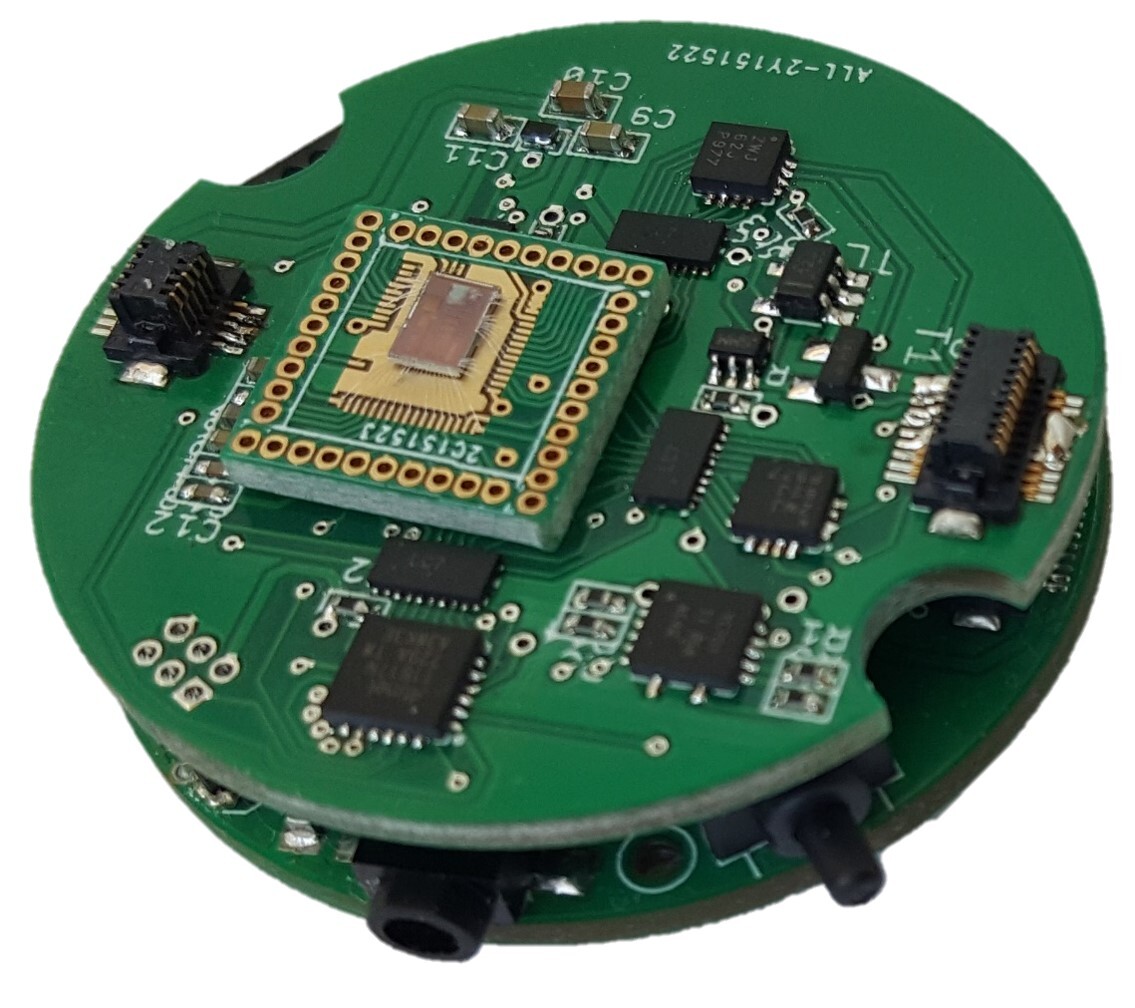

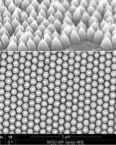
Publications:
- Valero-Sarmiento JM, Ahmmed P, Bozkurt A. (2020) In Vivo Evaluation of a Subcutaneously Injectable Implant with a Low-Power Photoplethysmography ASIC for Animal Monitoring. Sensors, 20(24), 7335.
- Reynolds J, Ahmmed P, Bozkurt A. “An Injectable System for Subcutaneous Photoplethysmography, Accelerometry, and Thermometry in Animals”. IEEE Transactions of Biomedical Circuits and Systems, 2019 Oct;13(5):825-834.
- Dieffenderfer J, Goodell H, Mills S, McKnight M, Yao S, Lin F, Beppler E, Bent B, Lee B, Misra V, Zhu Y, Oralkan O, Strohmaier J, Muth J, Peden D, and Bozkurt A. (2016) Low Power Wearable Systems for Continuous Monitoring of Environment and Health for Chronic Respiratory Disease, IEEE Journal of Biomedical and Health Informatics, 20:5. pp. 1251-1264.
- Ahmmed P, Dieffenderfer J, Valero-Sarmiento JM, Pamula VR, Van Helleputte N, Van Hoof C, Verhelst M, Bozkurt A. A Wearable Wrist-Band with Compressive Sensing based Ultra-Low Power Photoplethysmography Readout Circuit, 16th IEEE-EMBS International Conference on Wearable and Implantable Body Sensor Networks (BSN’19), Chicago, IL.
- Sotory P, Bozkurt A. (2019) Biomimetic Nanostructure Fabrication to Increase Light Transmission Efficiency in Optoelectronic Devices, IEEE SENSORS 2019, Montreal, Canada.
Focus 3: Textiles-Based Wearable and Ubiquitous Sensing
iBionicS’ main contribution in this field has been on multi-modal sensors integrated into textiles through the design of the cross-section of co-extruded multicomponent textile fibers. These textiles can sense tactile forces, wetness, and biopotentials simultaneously. iBionicS team extended this work to monitor the inner-socket environment for lower-limb prosthetics. In addition to sensing fibers, the iBionicS team has also worked on screen-printing sensors on non-woven substrates, improving the textile interconnect technologies and providing on-board front-end circuits for wireless sensing for textile based physiological sensing.

Publications:
- Agcayazi T, Tabor J, McKnight M, Martin I, Ghosh T, Bozkurt A.(2020) Fully-Textile Seamline Sensors for Facile Textile Integration and Tunable Multi-Modal Sensing of Pressure and Wetness, Advanced Materials Technologies, 5(8), 2000155.
- McKnight M, Tabor J, Agcayazi T, Fleming A, Ghosh T, Huang H, Bozkurt A. (2020) Fully-textile Insole Seam-line for Multi-modal Sensor Mapping, IEEE Sensors Journal, 20:17, 10145 – 10153.
- Kapoor A, McKnight M, Chatterjee K, Agcayazi T, Kausche H, Bozkurt A, Ghosh T. (2019) Toward Fully-manufacturable Fiber Assembly based Concurrent Multimodal and Multifunctional Sensors for E-textiles, ACS Applied Materials and Interfaces. Advanced Materials Technologies 4.1: 1800281.
- McKnight M, White R, Agcayazi T, Tabor J, Ghosh T, Bozkurt A. (2018) A Wetness Detection Technique Towards Scalable, Array-Based, Fully-Textile Sensing, IEEE BioCAS 2018, Cleveland, OH.
Focus 4: Stretchable and 3D-Printed Bioelectronic Interfaces
The iBionicS team’s efforts have also been on the development of more efficient interfaces to record the body’s bioelectrical properties, in particular surface biopotentials and bioimpedance recorded from plants and canines. For this, iBionicS has been collaborating with Biointerface Lab at NC State to design very-thin and stretchable epidermal electrodes for plant leaves as well as 3D-printable, conductive polymer based electrodes with unusual geometries to penetrate through the animal fur.
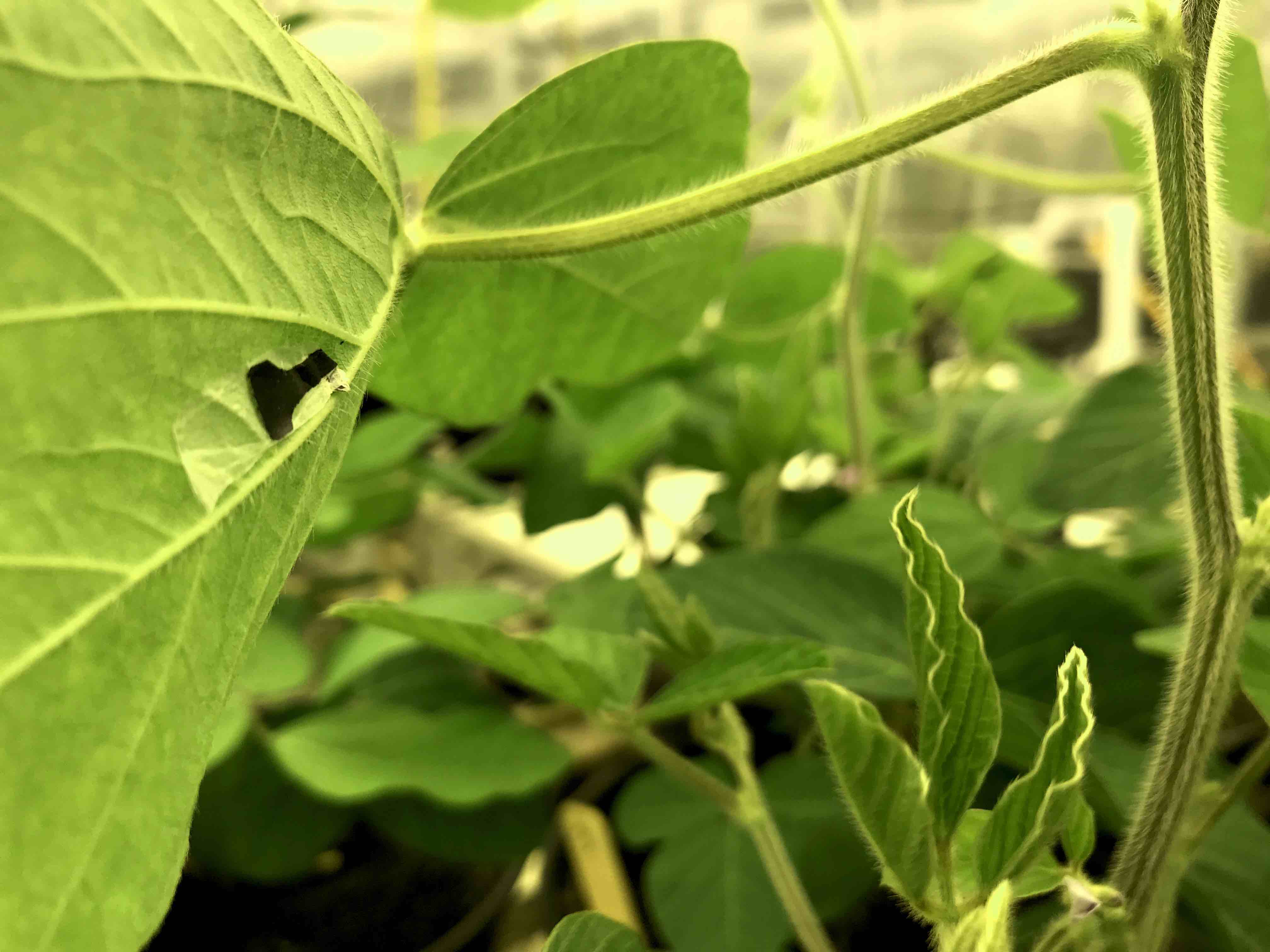


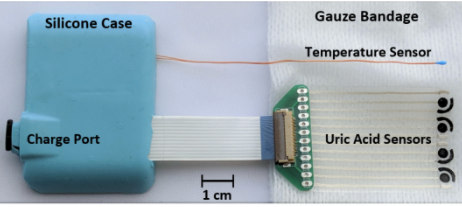
Publications:
- Foster M, Brugarolas R, Walker K, Mealin S, Cleghern Z, Yuschak S, Condit J, Adin D, Russenberger J, Gruen M, Sherman B, Roberts D, Bozkurt A. (2020) Preliminary Evaluation of a Wearable Sensor System for Heart Rate Assessment in Guide Dog Puppies. IEEE Sensors Journal, 20:16, 9449-9459.
- Ahmmed P, Reynolds J, Hamada S, Regmi P, Bozkurt A. (2021) Novel 3D-printed Electrodes for Implantable Biopotential Monitoring Applications. 43rd Annual International Conferences of the IEEE Engineering in Medicine and Biology Society (EMBC), Virtual.
- Keller K., Wilkins M., Tunc-Ozdemir M., Reynolds J., Dieffenderfer J., Hood C., Daniele M., Bozkurt A. (2016) “Nanocellulose Electrodes for Interfacing Plant Electrochemistry”, IEEE SENSORS 2016, Orlando, FL.
Focus 5: Technology Integration for Novel Wearables
Solving the wearable interface challenges at various boundaries has enabled the iBionicS’ Testbeds and also let the team lead the Health and Exposure Tacking Testbed for the NSF Engineering Research Center for Advanced Self-Powered Systems of Integrated Sensors and Technologies (ASSIST Center). For these, iBionicS team has been able to integrate a number of commercially available sensors and interface electronics into the animal wearables and injectables to allow for correlated sensing of physiology and behavior through the use of machine learning. For ASSIST Center, the team has been integrating a number of low-power sensors and energy harvesting devices delivered by various research thrusts into the wearable form factors for humans (i.e. wrist-band and chest-patch). iBionicS efforts on this thrust have been more about embedded systems design and packaging.
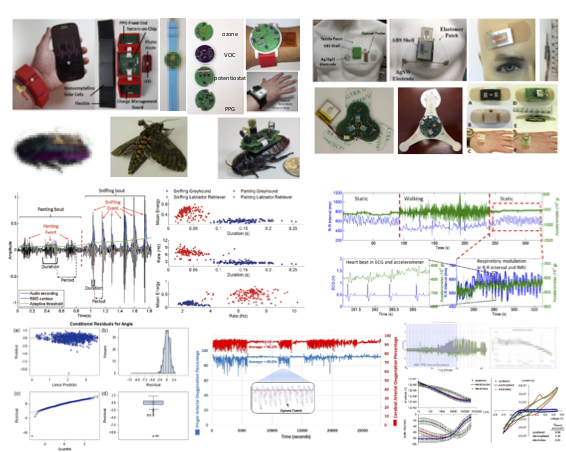
Publications:
- Songkakul T, Peterson K, Daniele M, Bozkurt A. (2021) Preliminary Evaluation of an Energy-Harvesting Wristband for Continuous Multi-Modal Electrochemical Monitoring. 43rd Annual International Conferences of the IEEE Engineering in Medicine and Biology Society (EMBC), Virtual.
- Dieffenderfer J, Goodell H, Mills S, McKnight M, Yao S, Lin F, Beppler E, Bent B, Lee B, Misra V, Zhu Y, Oralkan O, Strohmaier J, Muth J, Peden D, and Bozkurt A. (2016) Low Power Wearable Systems for Continuous Monitoring of Environment and Health for Chronic Respiratory Disease, IEEE Journal of Biomedical and Health Informatics, 20:5. pp. 1251-1264.
- Songkakul T, Bhushan B, Umasankar Y, Yokus M, Daniele M, Bhansali S, Bozkurt A. (2019) Towards a Long-Term Multi-Site Electrochemical Wound Monitoring System, IEEE SENSORS 2019, Montreal, Canada.
- Latif T, Gonzalez L, Dieffenderfer J, Liao Y, Hernandez M, Misra V, Lobaton E, Bozkurt A. (2020) Preliminary Assessment of Human Biological Responses to Low Level Ozone. IEEE SENSORS 2020, Rotterdam, The Netherlands.
- Dieffenderfer J, Goodell H, Mills S, McKnight M, Yao S, Lin F, Beppler E, Bent B, Lee B, Misra V, Zhu Y, Oralkan O, Strohmaier J, Muth J, Peden D, and Bozkurt A. (2016) Low Power Wearable Systems for Continuous Monitoring of Environment and Health for Chronic Respiratory Disease, IEEE Journal of Biomedical and Health Informatics, 20:5. pp. 1251-1264.